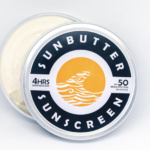The short version: sunscreen kills coral. There are four major, common ingredients in sunscreen which are toxic to corals and other marine life. Sunscreen is now starting to be banned in places like Hawaii which have suffered massive damage from sunscreen poisoning.
This article is only about sunscreen and the ocean. If you’re not getting in the water, there are other factors to consider.
While there are plenty of good articles on this already, here’s some bullet points about “normal” sunscreen:
- Sunscreen needs time (~30 min) to absorb into your skin.
- Sunscreen which sits on top of your skin in a creamy glaze simply washes off in the water, killing everything.
- The best option is to cover up – with a big hat and a long sleeve shirt. Try leggings/yoga pants or similar to avoid leg burns.
- There are reef-safe alternative sunscreen materials!
The four ingredients to avoid
Avoid reef-damaging substances such as:
- Oxybenzone (Benzophenone-3, BP-3)
- Butylparaben
- Octinoxate (Ethylhexyl methoxycinnamate)
- 4-methylbenzylidene camphor (4MBC)
If you read the ingredients on the bottle and see one of these – don’t use it near the ocean.
Other ingredients to avoid
Retinyl Palmitate: May speed development of skin tumors and lesions.
Oxybenzone: In addition to being bad for the reef, it gets into the bloodstream and can act like estrogen in the body.
Avobenzone: Becomes toxic when combined with chlorinated water (like from a swimming pool).
What’s good?
non-nano Zinc oxide. Blocks UVA and UVB. The preferred option, but can have a whitish look.
non-nano Titanium dioxide. Blocks UVB only.
Avobenzone, but only in the ocean.
On “nano” zinc and titanium compounds:
Zinc & titanium are minerals; think of them like tiny grains of sand, or flakes of rust. The smaller they are, the harder they are to see (the product ends up clear), but it can introduce issues with photocatalysing and potential toxicity to marine life. However, the science does not seem to be indicating there are human health risks with nano-zinc/titanium skin creams. In any case, it is best to use non-nano zinc and titanium, which is less toxic to marine life than the nano-versions.
Reef safe sunscreens
Blue Lizard
Australian. Zinc and titanium based. Only get the baby or sensitive skin versions!
Badger
Zinc based.
Caribbean Solutions
Zinc and titanium based. With aloe vera.
Vanicream
Zinc & titanium based, designed for sensitive skin.
Manda
Thanaka based (Burmese tree bark).
Raw Elements
Zinc based.
All Good
Zinc based.
Magwai
Philippines. Zinc and titanium based.
Currently only available in the Philippines. 599PHP ($11.40USD) for a 100ml tube.
Sunbutter
 Zinc based, Australian made. $20AUD per tin. Very natural ingredients, and comes in four colours/tints (one is clear).
Zinc based, Australian made. $20AUD per tin. Very natural ingredients, and comes in four colours/tints (one is clear).
https://sunbutteroceans.com.au/collections/all
And plenty more to be found. Stay sun safe, be reef smart!
Sources:
https://www.seacrush.com/en/articles/reef-safe-sunscreens-that-are-good-the-skin-and-the-environment/
http://scubadiverlife.com/top-four-reef-safe-sunscreens/
Further reading
PADI article in 2016 by Megan Denny.
Environmental Working Group:
- How to pick a good sunscreen
- 8 Little-Known Facts About Sunscreens
- The Trouble With Ingredients in Sunscreens
On Avodenzone from the DailyMail (June 2017).

